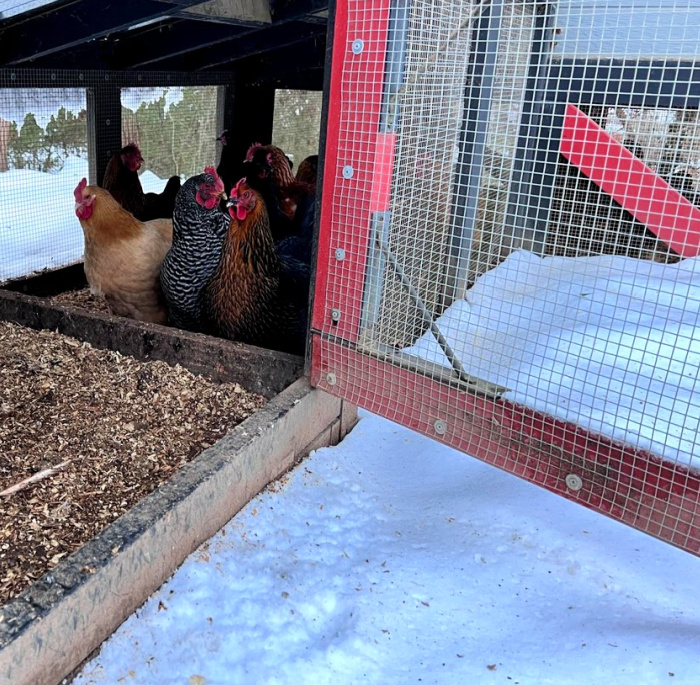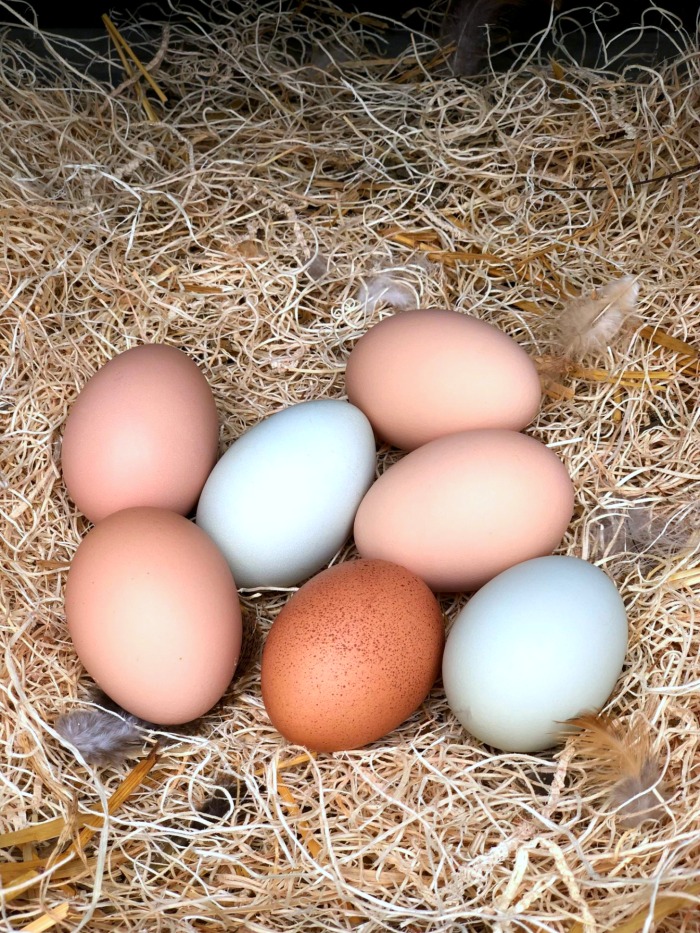
As the days grow shorter and the air turns crisp, it’s that time of year again – winter is just around the corner. For backyard poultry keepers, it’s essential to prepare your chicken coop and coturnix quail aviary for the chilly months ahead. Winterizing your coop and aviary ensures that your feathered friends are kept warm, safe, and healthy throughout the cold season. In this guide, we’ll walk you through the process, from creating a supply list to important tasks and valuable tips to keep in mind. Learning how to winterize your chicken coop or how to prepare your coturnix quail for a long cold spell is easy, peasy, lemon squeezy.
Supply List for Winterizing your Chickens and/or Coturnix Quail:
Essentials for Prepping Your Chicken Coop for Winter:
*Affiliate Links Below*
- Insulation Materials: Gather straw, hay, or other insulating materials to make your coop and aviary warm and inviting. We use fine ground pine chips (meant for livestock) and line the nesting boxes with untreated grass germination mats. I keep meaning to make a video on how to make these low cost liners!
- Sand for Coop Floor: Add sand to the coop floor for moisture control and easier cleaning. Think of it as cat litter for chickens.
- Gloves: I think this one is self explanatory… Poop….Protect your hands during cleaning and maintenance tasks.
- Rake: Keep your coop and aviary clean and debris-free with a trusty rake. Its like a cat litter scoop, but giant sized, if you use sand in the floor of your coop.
- N-95 Mask: Guard against dust and excrement particles with an N-95 mask while working in the coop and aviary. Cause I don’t want poop lung to be a thing.
Nice-to-Have Supplies for Winterizing Your Poultry:
- Heated Waterers: Keep water liquid and accessible to your chickens and quail in freezing temperatures. Do I have these? No, because I am cheap. And work from home so its easy to switch waterers in and out. We used to have a homemade one, but retired that for a real one, over time. I got nervous about potential for fire. If you want to make your own here is a link to our previous tutorial. Build at your own risk.
- Tarps or Plastic Sheeting: Create windblocks and protect outdoor runs from chilly winds and precipitation. See below on NOT sealing your chicken coop in the winter. DO NOT SEAL. I repeat DO NOT SEAL.
- Extra Feed and Supplements: Ensure your birds are well-fed and nourished throughout the winter.
- Lighting: We do not supplement the light our chickens receive so we get very few eggs over the winter. If you desire eggs over the winter you may want to consider adding additional light
Tasks for Preparing Your Quail & Chickens for Winter
- Deep Cleaning: Start your winter preparations with a thorough cleaning of the coop and aviary. Since your animals will spend more time indoors, maintaining a clean and sanitary environment is crucial. I mean who wants to be locked in with a pile of your own poop?
- Wind Blocks and Shelter: Install wind blocks using tarps or plastic sheeting to protect your birds from cold drafts. Ensure that the coop and aviary have sufficient insulation to maintain a comfortable temperature. Your quail will 100% ignore all your efforts, sit out in the open with a dusting of snow across their feathers…. but you will feel better knowing you tried.
- Health Check: Before winter sets in, inspect all your birds for any signs of pests, diseases, or health issues. Address any concerns promptly to ensure your flock is in top condition. In my case, I have 2 quail that get poop stuck to their feet. Even when I keep everything nice and clean. I watch their twos and clean it off before it becomes poop balls. I assume these 2 quail pay attention to their hygiene about like my middle school sons.
You can watch our Youtube video on how we achieve all these tasks:
Tips For Keeping Chickens & Quail Healthy All Winter Long
- Ventilation is Key: Avoid sealing the coop too tightly. Proper ventilation helps maintain good air quality and reduces the risk of respiratory issues. The best way to describe it. Imagine your hot wet breath in a sealed cold area. All the moisture would condense on the cold walls. Now imagine all that cold wet air circulating above your poop… Yeah….
- Cleanliness: Chickens tend to hide in the runs and coop whenever snow falls or weather is inclement. This leads to additional poop. Keep an eye out and potentially rake out the coop and runs more often. Quail will often get poop stuck to their feet as it will not dry as fast in colder/damp months. Keep an eye on wood chips and change out regularly
- Collect Eggs Frequently: Prevent eggs from freezing and cracking by collecting them regularly. Even if they do not lay often noone needs a cracked frozen egg thawing all over your aviary floor or chicken nesting boxes. If this seems real specific… It is.
- Monitor Your Local Alerts: We often receive alerts of avian flu being passed from wild birds in the fall and winter. Keep an eye out on times you may want to keep the chickens inside a secure location
Creating a Cozy Home:
To create a warm and cozy environment for your feathered friends, you’ll want to focus on insulation. Straw or hay provides excellent insulation for the coop while maintaining breathability. Layer it thickly on the floor and in nesting boxes, and replace it regularly to maintain warmth and cleanliness. For the quail aviary, consider adding extra straw to the ground to create a soft, insulating bed. I also add boxes and additional hidey holes for them to use. REMEMBER: do not seal your coops or aviary. It is important that airflow be maintained. A sealed environment will collect moisture from the respiration of chickens and quail. Damp air and cold is just a recipe for upper respiratory infections.
Winterizing with Tarps and Plastic Sheeting:
Winter winds can be harsh, and precipitation is no friend to your coop and aviary. To keep your birds cozy and dry, create windblocks using tarps or plastic sheeting. Attach them to the coop’s sides and cover outdoor runs. This simple step will make a world of difference in keeping the cold and wet weather at bay. Yes I am going to say it again: Create windblocks but do not create an environment that seals in dampness. We are striving for dry as possible all winter long.
Nurturing Your Flock:
Your birds will sometimes need extra nourishment during the winter months. It takes calories to maintain body mass in the cold. Consider increasing their feed, and don’t forget to offer supplements. Oyster shells are a great source of calcium for laying hens and if they aren’t laying over the winter then they can replenish the calcium in their bodies. Extra grains and protein can help your birds stay healthy and warm during the colder days. The focus should be on a quality protein high food. We like to offer some suet as a treat as well so they can have some extra fats in their diet. Since we treat the winter as a rest break from laying we really try to give the girls some quality nutrition during this time. I’m looking into starting a fodder system to increase their access to fresh greens during the winter as soon as out home renovation is complete.
Heating and Lighting:
While it’s tempting to add heaters to your coop, it’s best to avoid them. Overheating can lead to respiratory issues and fire hazards. Instead, rely on good insulation and wind protection. To maintain egg production, add supplementary lighting to extend daylight hours and keep your hens happy. As we mentioned, we allow our chickens to rest through the winters and take the few eggs they provide. However, it is up to you. Each chicken is born with the total amount of eggs it will lay, so, you really can’t up the limit, it is more when they will come out. Since we tend to keep a long term mixed age flock, it makes sense to give them rest breaks so they lay longer during their lifespan. If you are only keeping layers for a year or two then it makes sense to light them over the winter.
Conclusion:
With the right supplies, tasks, and tips, you can ensure your chicken coop and coturnix quail aviary are ready for the winter months. Keeping your birds warm, healthy, and happy will make the colder season a breeze. If you have any questions on this how to winterize article please let me know in the comments.
So, don’t let winter catch you off guard – get your coop and aviary ready for the snow and frost, and enjoy a cozy, stress-free season with your beloved flock and quail. Cleaning and prep in fall means less time running around in the cold for both you and your chickens & quail. I learned the hard way that giving your chickens winter protection in the middle of a storm is NOT fun. For you or the chickens :) so don’t procrastinate and get your flock ready for winter today!























